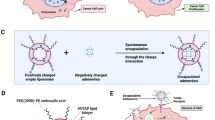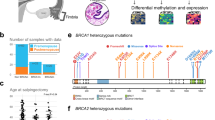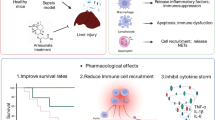Abstract
Sepsis-related complications and mortality remain a major clinical problem. Increased cell death and unresolved cellular repair have been implicated as key upstream mediators of sepsis-induced organ dysfunction and death. We hypothesised that gene therapy with BRCA1, a critical regulator of DNA damage repair and cell survival, would attenuate the sequelae of sepsis and peritonitis in mice subjected to caecal ligation and perforation (CLP) and thioglycollate stimulation. C57Bl/6J mice underwent sham or CLP surgery 3 days following treatment with either human BRCA1 adenovirus (AdBRCA1) or the adeno-CMV-null vector (Adnull). The 24-h post-CLP mortality was 2.8% vs 17.9% (P<0.001) and the median post-CLP survival was 50.5 vs 33 h (P<0.05) for AdBRCA1- vs Adnull-treated mice, respectively. AdBRCA1 therapy blunted CLP-associated cardiac, pulmonary, hepatic and renal dysfunction and also reduced CLP-elicited double strand breaks and apoptosis in the liver. BRCA1 gene therapy was associated with lower CLP-evoked cardiac and hepatic superoxide generation that in the liver was in part due to improved reactive oxygen species removal. CLP also elevated mesenteric arteriolar and serum intercellular adhesion molecule-1, both of which were partially abrogated with AdBRCA1 administration. Thioglycollate-challenged AdBRCA1-treated mice displayed reduced peritoneal neutrophil recruitment and dampened cytokine elaboration relative to their Adnull-treated counterparts. Taken together, we report a novel role of BRCA1 gene therapy in limiting systemic inflammation, multiple-organ failure and mortality in experimental sepsis.
This is a preview of subscription content, access via your institution
Access options
Subscribe to this journal
Receive 6 print issues and online access
$259.00 per year
only $43.17 per issue
Buy this article
- Purchase on SpringerLink
- Instant access to full article PDF
Prices may be subject to local taxes which are calculated during checkout











Similar content being viewed by others
Accession codes
References
Canadian Institute for Health Information. Canadian Hospitals Aim to Reduce Mortality Rates, but Severe Infections Remain a Challenge 2009, http://www.cihi.ca/CIHI-ext-portal/internet/en/document/health+system+performance/quality+of+care+and+outcomes/hsmr/release_10dec09.
Levy MM, Dellinger RP, Townsend SR, Linde-Zwirble WT, Marshall JC, Bion J et al. The surviving sepsis campaign: results of an international guideline-based performance improvement program targeting severe sepsis. Crit Care Med 2010; 38: 367–374.
Houston G, Cuthbertson BH . Activated protein C for the treatment of severe sepsis. Clin Microbiol Infect 2009; 15: 319–324.
Rice TW, Bernard GR . Therapeutic intervention and targets for sepsis. Annu Rev Med 2005; 56: 225–248.
Marshall JC . Sepsis: rethinking the approach to clinical research. J Leukoc Biol 2008; 83: 471–482.
Alves-Filho JC, de Freitas A, Spiller F, Souto FO, Cunha FQ . The role of neutrophils in severe sepsis. Shock 2008; 30 (Suppl 1): 3–9.
Galley HF . Bench-to-bedside review: targeting antioxidants to mitochondria in sepsis. Crit Care 2010; 14: 230.
Hattori Y, Takano K, Teramae H, Yamamoto S, Yokoo H, Matsuda N . Insights into sepsis therapeutic design based on the apoptotic death pathway. J Pharmacol Sci 2010; 114: 354–365.
Rittirsch D, Flierl MA, Ward PA . Harmful molecular mechanisms in sepsis. Nat Rev Immunol 2008; 8: 776–787.
Ayala A, Perl M, Venet F, Lomas-Neira J, Swan R, Chung CS . Apoptosis in sepsis: mechanisms, clinical impact and potential therapeutic targets. Curr Pharm Des 2008; 14: 1853–1859.
Iwata A, de Claro RA, Morgan-Stevenson VL, Tupper JC, Schwartz BR, Liu L et al. Extracellular administration of BCL2 protein reduces apoptosis and improves survival in a murine model of sepsis. PLoS One 2011; 6: e14729.
Inoue S, Bo L, Bian J, Unsinger J, Chang K, Hotchkiss RS . Dose dependent effect of anti-CTLA-4 on survival in sepsis. Shock 2011; 36: 38–44.
Barkhausen T, Tschernig T, Rosenstiel P, van Griensven M, Vonberg RP, Dorsch M et al. Selective blockade of interleukin-6 trans-signaling improves survival in a murine polymicrobial sepsis model. Crit Care Med 2011; 39: 1407–1413.
Wang X, Zingarelli B, O’Connor M, Zhang P, Adeyemo A, Kranias EG et al. Overexpression of Hsp20 prevents endotoxin-induced myocardial dysfunction and apoptosis via inhibition of NF-kappaB activation. J Mol Cell Cardiol 2009; 47: 382–390.
Suzuki K, Murakami T, Kuwahara-Arai K, Tamura H, Hiramatsu K, Nagaoka I . Human anti-microbial cathelicidin peptide LL-37 suppresses the LPS-induced apoptosis of endothelial cells. Int Immunol 2011; 23: 185–193.
Feng H, Guo L, Song Z, Gao H, Wang D, Fu W et al. Caveolin-1 protects against sepsis by modulating inflammatory response, alleviating bacterial burden, and suppressing thymocyte apoptosis. J Biol Chem 2010; 285: 25154–25160.
Matsuda N, Teramae H, Yamamoto S, Takano K, Takano Y, Hattori Y . Increased death receptor pathway of apoptotic signaling in septic mouse aorta: effect of systemic delivery of FADD siRNA. Am J Physiol Heart Circ Physiol 2010; 298: H92–H101.
Hu H, Li X, Li Y, Wang L, Mehta S, Feng Q et al. Calpain-1 induces apoptosis in pulmonary microvascular endothelial cells under septic conditions. Microvasc Res 2009; 78: 33–39.
Perl M, Chung CS, Perl U, Lomas-Neira J, de Paepe M, Cioffi WG et al. Fas-induced pulmonary apoptosis and inflammation during indirect acute lung injury. Am J Respir Crit Care Med 2007; 176: 591–601.
Yeh CH, Cho W, So EC, Chu CC, Lin MC, Wang JJ et al. Propofol inhibits lipopolysaccharide-induced lung epithelial cell injury by reducing hypoxia-inducible factor-1{alpha} expression. Br J Anaesth 2011; 106: 590–599.
Inoue S, Unsinger J, Davis CG, Muenzer JT, Ferguson TA, Chang K et al. IL-15 prevents apoptosis, reverses innate and adaptive immune dysfunction, and improves survival in sepsis. J Immunol 2010; 184: 1401–1409.
Hsing CH, Chiu CJ, Chang LY, Hsu CC, Chang MS . IL-19 is involved in the pathogenesis of endotoxic shock. Shock 2008; 29: 7–15.
Chang KC, Unsinger J, Davis CG, Schwulst SJ, Muenzer JT, Strasser A et al. Multiple triggers of cell death in sepsis: death receptor and mitochondrial-mediated apoptosis. FASEB J 2007; 21: 708–719.
Greenberg RA . Recognition of DNA double strand breaks by the BRCA1 tumor suppressor network. Chromosoma 2008; 117: 305–317.
Scully R, Livingston DM . In search of the tumour-suppressor functions of BRCA1 and BRCA2. Nature 2000; 408: 429–432.
Buckley NE, Hosey AM, Gorski JJ, Purcell JW, Mulligan JM, Harkin DP et al. BRCA1 regulates IFN-gamma signaling through a mechanism involving the type I IFNs. Mol Cancer Res 2007; 5: 261–270.
Bae I, Fan S, Meng Q, Rih JK, Kim HJ, Kang HJ et al. BRCA1 induces antioxidant gene expression and resistance to oxidative stress. Cancer Res 2004; 64: 7893–7909.
Liu SF, Malik AB . NF-kappa B activation as a pathological mechanism of septic shock and inflammation. Am J Physiol Lung Cell Mol Physiol 2006; 290: L622–L645.
Schaub FJ, Han DK, Liles WC, Adams LD, Coats SA, Ramachandran RK et al. Fas/FADD-mediated activation of a specific program of inflammatory gene expression in vascular smooth muscle cells. Nat Med 2000; 6: 790–796.
Park DR, Thomsen AR, Frevert CW, Pham U, Skerrett SJ, Kiener PA et al. Fas (CD95) induces proinflammatory cytokine responses by human monocytes and monocyte-derived macrophages. J Immunol 2003; 170: 6209–6216.
Ahn JH, Park SM, Cho HS, Lee MS, Yoon JB, Vilcek J et al. Non-apoptotic signaling pathways activated by soluble Fas ligand in serum-starved human fibroblasts. Mitogen-activated protein kinases and NF-kappaB-dependent gene expression. J Biol Chem 2001; 276: 47100–47106.
Roy S, Nicholson DW . Cross-talk in cell death signaling. J Exp Med 2000; 192: F21–F25.
Hotchkiss RS, Swanson PE, Freeman BD, Tinsley KW, Cobb JP, Matuschak GM et al. Apoptotic cell death in patients with sepsis, shock, and multiple organ dysfunction. Crit Care Med 1999; 27: 1230–1251.
Boulton SJ . Cellular functions of the BRCA tumour-suppressor proteins. Biochem Soc Trans 2006; 34: 633–645.
Mullan PB, Quinn JE, Harkin DP . The role of BRCA1 in transcriptional regulation and cell cycle control. Oncogene 2006; 25: 5854–5863.
Singh KK, Shukla PC, Quan A, Al-Omran M, Jurasz P, Lovren F et al. BRCA1 is novel regulator of endothelial function and limits atherosclerosis. Circulation 2009; 120: S928.
Cave AC, Brewer AC, Narayanapanicker A, Ray R, Grieve DJ, Walker S et al. NADPH oxidases in cardiovascular health and disease. Antioxid Redox Signal 2006; 8: 691–728.
Boueiz A, Hassoun PM . Regulation of endothelial barrier function by reactive oxygen and nitrogen species. Microvasc Res 2009; 77: 26–34.
Abraham E, Singer M . Mechanisms of sepsis-induced organ dysfunction. Crit Care Med 2007; 35: 2408–2416.
Levy RJ . Mitochondrial dysfunction, bioenergetic impairment, and metabolic down-regulation in sepsis. Shock 2007; 28: 24–28.
Galley HF, Howdle PD, Walker BE, Webster NR . The effects of intravenous antioxidants in patients with septic shock. Free Radic Biol Med 1997; 23: 768–774.
Goode HF, Cowley HC, Walker BE, Howdle PD, Webster NR . Decreased antioxidant status and increased lipid peroxidation in patients with septic shock and secondary organ dysfunction. Crit Care Med 1995; 23: 646–651.
Huang Z, Zuo L, Zhang Z, Liu J, Chen J, Dong L et al. 3,3′-Diindolylmethane decreases VCAM-1 expression and alleviates experimental colitis via a BRCA1-dependent antioxidant pathway. Free Radic Biol Med 2011; 50: 228–236.
Goven D, Boutten A, Lecon-Malas V, Marchal-Somme J, Amara N, Crestani B et al. Altered Nrf2/Keap1-Bach1 equilibrium in pulmonary emphysema. Thorax 2008; 63: 916–924.
Kim HJ, Vaziri ND . Contribution of impaired Nrf2-Keap1 pathway to oxidative stress and inflammation in chronic renal failure. Am J Physiol Renal Physiol 2010; 298: F662–F671.
Mercado N, Thimmulappa R, Thomas CM, Fenwick PS, Chana KK, Donnelly LE et al. Decreased histone deacetylase 2 impairs Nrf2 activation by oxidative stress. Biochem Biophys Res Commun 2011; 406: 292–298.
Vecchio D, Arezzini B, Pecorelli A, Valacchi G, Martorana PA, Gardi C . Reactivity of mouse alveolar macrophages to cigarette smoke is strain dependent. Am J Physiol Lung Cell Mol Physiol 2010; 298: L704–L713.
Hofer S, Brenner T, Bopp C, Steppan J, Lichtenstern C, Weitz J et al. Cell death serum biomarkers are early predictors for survival in severe septic patients with hepatic dysfunction. Crit Care 2009; 13: R93.
Shukla PC, Singh KK, Quan A, Al-Omran M, Teoh H, Lovren F et al. BRCA1 is an essential regulator of heart function and survival following myocardial infarction. Nat Commun 2011; 2: 593.
Acknowledgements
Supported in part by a grant-in-aid award (Grant # 93704) from the Canadian Institutes for Health Research to S Verma. H Teoh was the St Michael's Hospital-sanofi-aventis Cardiometabolic Risk Initiative Research Fellow. KK Singh was the recipient of the Heart & Stroke Foundation of Canada/Pfizer Research Fellowship. S Verma is the Canada Research Chair in Atherosclerosis.
Author information
Authors and Affiliations
Corresponding authors
Ethics declarations
Competing interests
The authors declare no conflict of interest.
Rights and permissions
About this article
Cite this article
Teoh, H., Quan, A., Creighton, A. et al. BRCA1 gene therapy reduces systemic inflammatory response and multiple organ failure and improves survival in experimental sepsis. Gene Ther 20, 51–61 (2013). https://doi.org/10.1038/gt.2011.214
Received:
Revised:
Accepted:
Published:
Issue date:
DOI: https://doi.org/10.1038/gt.2011.214
Keywords
This article is cited by
-
BRCA-1 depletion impairs pro-inflammatory polarization and activation of RAW 264.7 macrophages in a NF-κB-dependent mechanism
Molecular and Cellular Biochemistry (2019)
-
Cardiac gene therapy: are we there yet?
Gene Therapy (2016)
-
Integrated genomic and prospective clinical studies show the importance of modular pleiotropy for disease susceptibility, diagnosis and treatment
Genome Medicine (2014)
-
Mouse models of BRCA1 and their application to breast cancer research
Cancer and Metastasis Reviews (2013)



